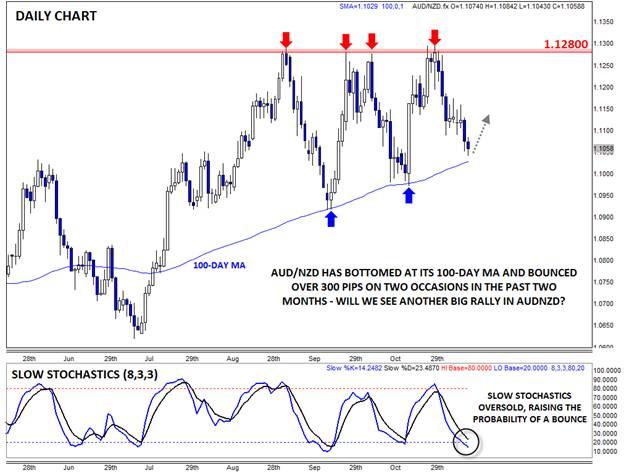![]()
As my colleague Chris Tedder
As is often the case, Kent’s full comments were not nearly as dovish as the headlines suggest when put into context. After extensively outlining the vulnerabilities of the Australian economy, he was asked whether the RBA would consider intervention, to which he responded, “We haven't ruled it out. It's still there as an option if needed." These comments merely restate the RBA’s long-standing policy, and do not suggest a major dovish shift or imminent intervention in our view.
As usual, traders adopted a “shoot first, ask questions later” policy, with AUDUSD briefly dipping below .8700 before recovering back up to hit a new high above .8750 in today’s European trade. The pair’s relative resilience in the face of poor Chinese data and ostensibly dovish headlines from the RBA suggests rates may rally further this week, perhaps to psychological resistance at .8800 or strong previous resistance near .8900 in time.
Technical View: AUDNZD
The AUDNZD cross is perhaps even more interesting. The Australian dollar is trading slightly lower against its antipodean counterpart today, but rates are approaching a critical support level at the 100-day MA. Over the past two months, AUDNZD has bottomed twice within a few pips of its 100-day MA and rallied over 300 pips each time. As we go to press, the pair is within 30 pips of this key support level, suggesting that another rally may be near at hand. The Slow Stochastics indicator bolsters the bullish case, showing that the pair is oversold (< 20) and raising the probability of a near-term bounce.
As long as rates hold above the 100-day MA at 1.1030, a rally will be favored. On the other hand, a confirmed break below this key support level would suggest that the “character” of the market has changed and would open the door for a deeper pullback toward the previous lows at 1.0975 or 1.0920 next.
This research is for informational purposes and should not be construed as personal advice. Trading any financial market involves risk. Trading on leverage involves risk of losses greater than deposits.
Recommended Content
Editors’ Picks
EUR/USD holds below 1.0750 ahead of key US data

EUR/USD trades in a tight range below 1.0750 in the European session on Friday. The US Dollar struggles to gather strength ahead of key PCE Price Index data, the Fed's preferred gauge of inflation, and helps the pair hold its ground.
GBP/USD consolidates above 1.2500, eyes on US PCE data

GBP/USD fluctuates at around 1.2500 in the European session on Friday following the three-day rebound. The PCE inflation data for March will be watched closely by market participants later in the day.
Gold clings to modest daily gains at around $2,350

Gold stays in positive territory at around $2,350 after closing in positive territory on Thursday. The benchmark 10-year US Treasury bond yield edges lower ahead of US PCE Price Index data, allowing XAU/USD to stretch higher.
Bitcoin Weekly Forecast: BTC’s next breakout could propel it to $80,000 Premium

Bitcoin’s recent price consolidation could be nearing its end as technical indicators and on-chain metrics suggest a potential upward breakout. However, this move would not be straightforward and could punish impatient investors.
US core PCE inflation set to signal firm price pressures as markets delay Federal Reserve rate cut bets

The core PCE Price Index, which excludes volatile food and energy prices, is seen as the more influential measure of inflation in terms of Fed positioning. The index is forecast to rise 0.3% on a monthly basis in March, matching February’s increase.
